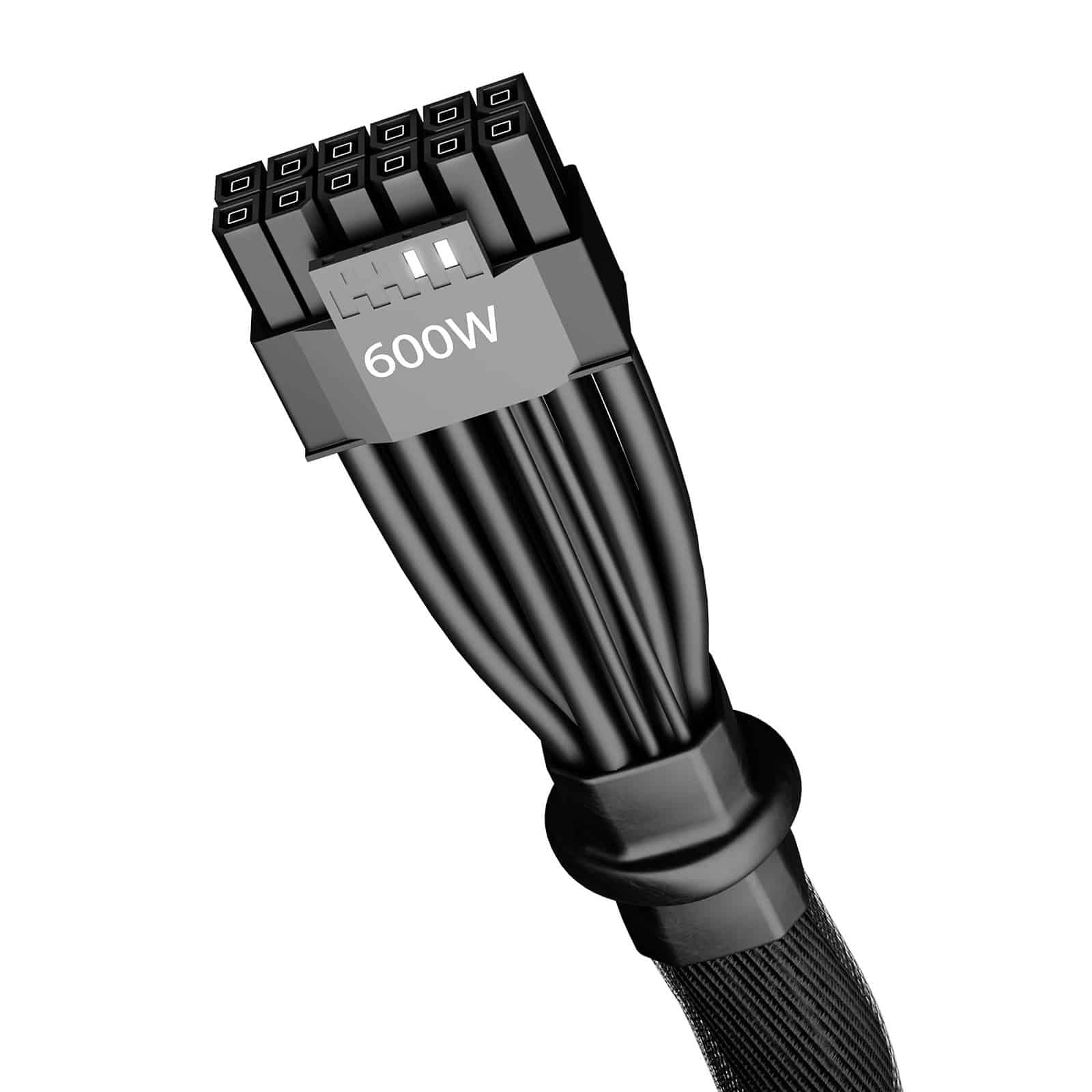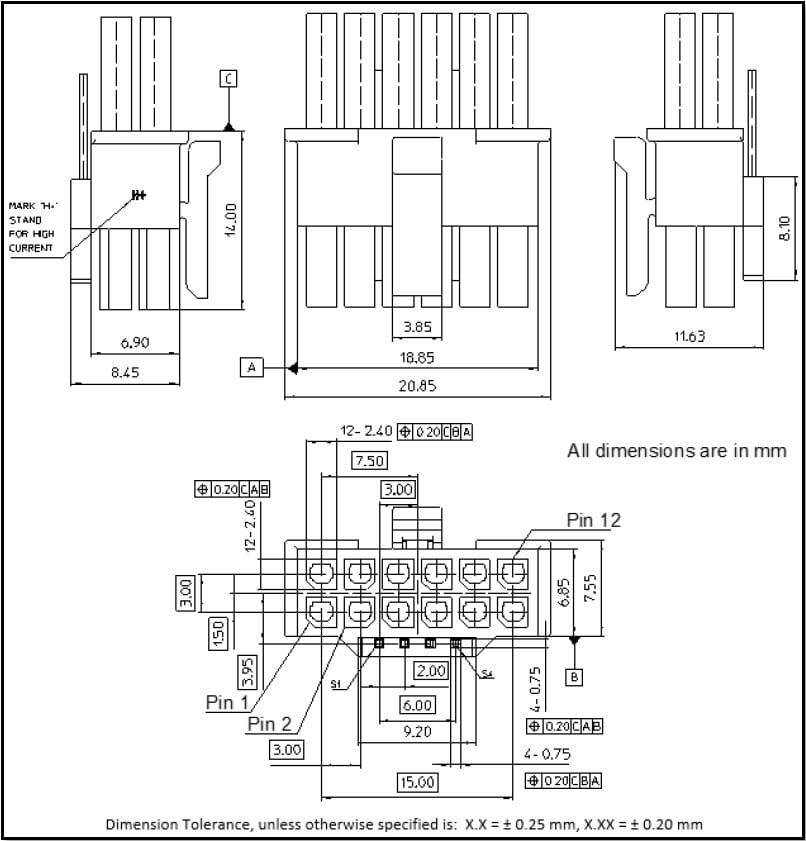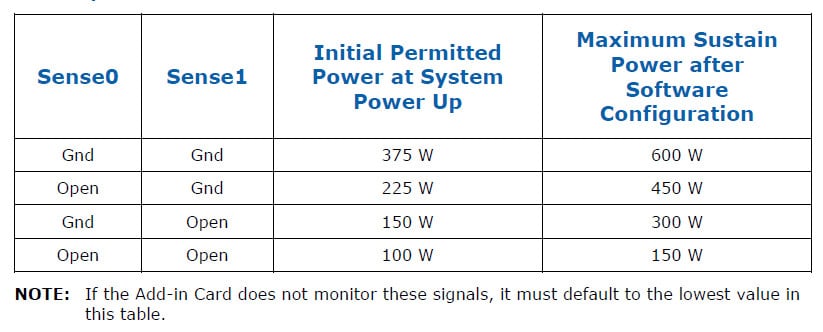Lots of talk (and drama) recently about the 12VHPWR connectors and cables, so I thought to write this article to clear out all this confusion. Although the 12 pin connector was released with the RTX 3000 series and there weren’t any major issues, it seems that the 12+4 connector (or 12VHPWR) raised lots of attention, and faced lots of critisism so far. But are things so serious, indeed?
Let’s make something clear from the start, addressing users unfamiliar with power supplies and their cables. The 12+4 pin connector, or 12VHPWR, has 12 pins, six for +12V (positive), six for COM (negative or common), and four for sense pins.
What do the Extra Four Sensor Pins do?
For starters, the four sensor pins don’t deliver current, but they are sense pins. Two of these sideband signals are required; the ones coming from the PCIe card are optional, while the ones coming from the power supply are required.
- SENSE0 (Required)
- SENSE1 (Required)
- CARD_PWR_STABLE
- CARD_CBL_PRES#
What is of interest to us are Sense 0 and 1 since these two pins are required and currently implemented on all 12VHPWR cables. These sense pins inform the graphics card of the PSU’s capability to deliver the power needed for the GPU. The following table shows the different configurations.
As you can see from the table above, to have the full power of 600W out of the 12VHPWR connector, both Sense 0/1 pins must be grounded. On the other hand, if these pins are both open, then the maximum sustainable power is only 150W, the same with the plain PCIe 6+2 connector. Naturally, if the graphics card doesn’t find these pins, it will assume they are both open, so 150W max.
600W Rated Cables vs 600W Set Cables
In the Seasonic TX-1600 PSU review that I wrote, I stated that according to Seasonic, this PSU is ATX v3.0 ready with up to 1000W loads, so it should have 450W 12VHPWR set connectors and not 600W. Beware, this doesn’t mean that its 12VHPWR cables cannot handle 600W, and they will melt with this amount of power! I suggested that according to Intel’s test plan, a 1000W PSU cannot have its 12VHPWR connector’s sense pins set for 600W but only 450W, especially since it has two!
Take a good look at the table below, and we will analyze this matter afterward. Note you won’t find this table anywhere else, so pay extra good attention to it!
This is what the Intel v3.0 Test Plan Calculator states. PSUs with 1100W or more can have 600W 12VHPWR connectors/cables, while PSUs within the 900-1099W range drop to 450W. The 300W and 150W settings are for lower-capacity units. This is to protect system restarts. Imagine a 750W PSU having a 12VHWR connector set for 600W output, in other words informing the graphics card that it can deliver up to 600W, powering an RTX 4090 with its power limit to the full (600W) and a power-hungry CPU. Most likely, you will face system restarts under heavy loads. This is why the PCI-Sig thought to implement the Sense 0/1 pins and provide protection against overloading the PSU. If your PSU has enough juice to provide, everything is fine, and you can go up to 600W. In the opposite case, it will be restricted according to its capacity.
The problems in 600/450/300/150 12VHPWR Connectors/Cables
Everything looks good in what the PCI-SIG thought about the different settings on the 12VHPWR cables and connectors, but so far, most brands ignore this guideline and provide 12VHPWR cables set for full power output (600). The problem in keeping a portfolio of different ratings of 12VHPWR cables and combining them with the corresponding PSUs led most brands to act like this: use the same 12VHPWR cables for all of their PSUs, regardless of capacity, and get over with the variations of the new connector. With the PCIe 6+2 cables, things were simple, you only had one connector type with no sense pins and settings, but the 12VHPWR is a different beast, making things more complex for all brands and manufacturers. A break-in period is required.
Imagine the two following scenarios:
Scenario #1: A user gets his new 1000W PSU which can power fine an RTX 4090, even with its power limit set at 600W, but its 12VHPWR connector’s Sense 0/1 pins are set for 450W. So the cable informs the graphics card that it cannot deliver more than 450W to it, which doesn’t stand, so the card is locked at 450W. This will create frustration for the user, who spent a notable amount to get a good 1000W PSU. From the moment, the RTX 4000 series doesn’t have the enormous power spikes that the PCIe 5 does.0 standard supports, there is no need for such tight power restrictions on the cables. This is what most brands thought, too.
Scenario #2: A user has a 750W PSU with a 12VHPWR connector set for 600W power output. The cable can handle full power, but the PSU will have a tough time under an extreme scenario, with an RTX 4090 at 600W and an Intel 13900K or an AMD Ryzen 9 7950x CPU running a heavy load at the same time. Most likely, the PSU will restart under a high load, especially if its over power protection is conservatively set, and this is the proper thing to do, to warn the user that he/she pushed it too far. Apart from a system restart, there won’t be any issues in the form of melt connectors, cables, etc., since the 12VHPWR connector can handle 600W. It is the PSU that will have a problem delivering them while also powering the CPU and the rest system parts.
I hope I made things clear with the two examples mentioned above.
What Is The Best To Do?
The solution is somewhere in the middle. A 1000W PSU can have a 12VHPWR connector set for 600W power output and work fine without any restart issues. Depending on the CPU’s power consumption, even a high-end 850W PSU could handle it. Most games don’t tax the CPU heavily. You can look at my article, NVIDIA RTX 4090 Detailed Power Analysis & Ideal Power Supply, to have a good idea of a system’s power consumption with an RTX 4090. There is no need for speculations, I have the Powenetics V2 system fully operational, and I can extract the power readings I want, including power spikes.
For 750W PSUs, I would suggest a 450W setting for the 12VHPWR connector to avoid pushing the PSU hard, and facing possible system restarts. Many PSUs have high over power protection triggering points; I have seen 750W PSUs delivering more than 1000W before shutting down, but overpowering your PSU is not the wisest thing to do.
In any case, you should remember this. The 12VHPWR connector’s Sense 0/1 pins setting doesn’t have to do with the power that it can handle! You can have a 600W-rated cable set at 450W because it is shipped with a 750W PSU. We might see lower power rating 12VHPWR cables, with fewer 12V and COM wires, anytime soon. This is a totally different case. But from the moment these cables will have their Sense 0/1 pins accordingly, they will be safe. If they don’t, then I will be here to highlight any possible problems!






I need your help I’m currently building pc with 9800x3D and rtx 5070 ti and micro center suggested me xpg kyber 850w i just wanted to know if that’s good option or no
Hi, really well explained article, I’m glad I found it.
Im building a new desktop and I have a PSU “Asus tuf gaming 750g (750w)” ATX 3.0, with one 12VHPWR type connector,there are only two PCI-E cables for the graphics card that comes with that power supply:
Single cable, on the GPU side 8pin (6+2), on the PSU side 8pin header/ connector.
Second single cable, on the GPU side: two separate (2×6+2), on the PSU side: 16pin (12+4) 12VHPWR type connector
My question is can I connect rx 7700xt with that second single cable GPU: (2×6+2) – PSU: 16pin (12+4) since the graphics card has 2x8pin connectors?
It is a Sapphire Nitro card which is rated up to 252W, but it could probably go higher, so I asume this “12VHPWR max power” of 300W be enough?
Also, since that type of cable/connector is proprietary to Nvidia, are they okay for AMD Radeon GPUs?
I believe you won’t have an issue to use the 12VHPWR to 2x PCIe 6+2 pin connectors, cable. If you want to be extra safe you could use one of them and the dedicated PCIe 6+2 pin, but this could be overkill.
Ok, thank you.
Hi again , sorry I have one additional question,I have two identical PSUs “Asus tuf gaming 750g 750w modular”, the only difference is that one is 3.0 and the other 3.1 ATX standard, okay I know the difference is that 3.0 has 12VHPWR while 3.1 has 12v-2×6 header on PSU side, but what about other standard non 5.0/5.1 cables/headers coming with the PSU, for example 24 pin MB, cpu/pcie PCIE 4.0 cables/headers, are they the same on both PSU 3.0 and 3.1?
To clarify can we use PSU ATX 3.1 cables on same brand/model/wattage PSU 3.0?
Hi, thanks for this read & info, much appreciated.
I have a Seasonic Prime PX-1300 which is not even ATX 3.0, & plan on getting an ASUS 5090.
Am I ok still using that PSU with the 5090 even though it’s not ATX 3.0/3.1? Will the 5090 get all the power it needs??
I’m currently using an ASUS 4090 with this PSU & have been for a while & have seen my GPU hit near 400W maybe even a bit more. What do you think? Should I upgrade to ATX 3.1 or am I fine?
If you get a proper cable taking power from the PSU’s sockets directly I guess you will be ok. The RTX 5090 normally won’t be much more power hungry than the 4090
Hi, thanks for replying. Well I’m just planning on using the power cable that comes with the 5090, which is the same as the 4090 but with the updated 12V-2×6 connector to 4x 8-pin. Is that considered a proper cable?
I was worried about connecting my ATX 2 PSU to the 5090, & the sense pins requesting less power than 600W from PSU due to ATX 2 not connecting to those sense pins & your table. But I think I was just confused.
I’ll eventually upgrade to 3.1, such a mission though so I’ll put it off for now.
Appreciate your time.
You will be ok yes.ATX v3.0 means that your PSU has 12VHPWR header instead of 12V-2×6. We usually don’t see any problems on the PSU side unless something is way wrong there.
LEADEX VII Platinum PRO 1200 Вт ATX 3.1 Стоит ли его покупать? Конфигурация системы i9 13900k , RTX 4070Ti/4090.
Dear Aris,
hopefully, you see this. I recently bought a RTX 4070 Ti Super and a 850W Gold ATX 3.0 (Seasonic Vertex). With the discussion going on about 12VHPWR / 12V-2×6 600W cables and its connectors, I also wonder about the lifespan of the connector of the graphics card. Seasonic outlined 30 mating cycles. Does that include the connector on the graphics card too?
Many regards!
Thank you for the very informative read help me tackle any problems beforehand.
Glad I helped 🙂
Can I still use a 850 PSU to run a 4090 using the 12-pin PCIe 5 connector?
right now I have a 4070 super settled like that, but I’m wondering about the 4090 using a 850w
Thank you
It depends on the CPU you have. I wouldn’t go for a 850W PSU though for a 4090 in general. 1000W at least with 1200W being ideal.
I have a 1000W Seasonic Prime Titanium PSU (TX Prime 1000) with an Asus RTX4060TI GPU (with an Intel 13700K on an Asus Z790 board). The 4060TI (two fan), only has an one 8pin power connector. (I did buy the 4060TI for lower power requirements with extra memory on board). Question is…. Am I safe just using the standard Seasonic GPU 8pin cable&connector? Or do I need a different cable?
(Seasonic gives a warning on their website:)
Your card uses a single 6+2 PCIe? If so, I don’t see a reason that should make you worry. Or I cannot understand what cable you are referring to because it looks weird for Seasonic to provide a warning for the standard 6+2 PCIe cable.
Hey there. This is still all a bit confusing to me. I just purchased a really nice Thermaltake prebuilt with an RTX 4080 connected to a Thermaltake GF3 850W PSU. The connector they used was a single 16 pin 12VHPWR that is labeled 300W. Nvidia recommends that the 4080 is connected to a minimum of a 450W cable. If the 300W label is not a limit, why is it written on the cable? I’m trying to find definitive info on this as it would appear the wrong cable was used in the build, but 12VHPWR is extremely confusing. Should I contact Thermaltake and ask them for a 450W cable?
Prebuilds are a bit confusing and afaik not many 12vhpwr are really less than 600w capable. I dont think that TT made a mistake, but u might need to contact them for your question to be answered. Maybe labeled 300w because your PSU is 850w? Maybe Aris has sth more to say, of course.
Hi,
I am looking to buy Rm1000e for my arriving newly buyed Palit RTX 4090(non OC). As I understand PSU will be limited on 450w on 12VHPR Pcie5 connector, so for this GPU card it should be enough as it’s limited to around 450w but looking to future proofing side if later on next gens I would get more power hungry GPU card hypotheticaly let’s say 550w when I will have to change PSU to at least 1100w as stated to get 600w on 12HPWR, is that right? Does this 1000w psu will be limited to 450w on 12VHPWR?
Why wont u take rmx shift? Aris posted an article about the little performance impact. Now, if u want to be overcovered maybe u should check rm1200 shift, if your Case is compatible, of course.
Can the 12VHPWR on a silverstone 1200 watt atx3.0 psu be used to power a 7900xtx with 3 8 pins?
With the use of adapters it could, though, but from the moment the PSU has 6+2 pin PCIe, you should prefer these.
I need some clarification please. I have a Seasonic Prime 850W Titanium PSU and I am upgrading my GPU to an RTX 4080. Seasonic indicates all I need is 12VHPWR connector to (x2) 8 pin PCIe connector cable. When searching Amazon I found a Seasonic compatible cable that offers x2, x3, x4 8 pin PCIe. If I went with just the x2, am I going to experience any performance issues? What quantity 8 pin should I really get?
I would use 3x PCIe 6+2 pin -> 12+4 pin, at least, and not a plain 2x which is good only for up to 300W officially.
Thanks for the quick response!
Wish I knew why Admins are deleting my comments when I am trying to share first hand personal experience regarding these cables. I bought a 1000w PSU Thermaltake gf3. It came with a 600w 12VHPWR cable. It was not working right so I put in a RMA claim and they sent me a new cable. When it arrived it was a 450W 12VHPWR cable. I questioned Customer Support and they said their original cables were all mislabeled and that it should have said 450W. Has anyone else had experience like this? Mods, why delete this honest question?
We don’t delete anything 🙂
Thermaltake’s PMs told me that all cables would be 600W. I cannot know why they decided to change this. As I said in a previous reply, normally 1000W PSU should come with 450W 12VHPWR, as the ATX v3.0 dictates and not 600W.
This seems to be a decent 600w rated cable. https://www.amazon.com/gp/product/B0BX52R2XH/
Pcie 5.0 GPU Power Cable,16AWG ATX 3.0 12VHPWR PCI-E Cable,600w 16pin (12+4) 12VHPWR Male to Male Pcie 5 Power Cable for Geforce RTX 3090Ti 4070 Ti 4080 4090 to Modular Power Supply(75cm)
Brand: Motusamare
Better contact Thermaltake as they are sending replacement cables (12VHPWR) in 450W meanwhile my 1000w GF3 came with a 600W. When I asked customer service about this they said “The cable is the same and they are rated the same on our end they were mislabeled and we are using the same cables through the entire units.”
I don’t know what this means, my original cable that came with my PSU was 600W, the replacement they sent me was 450W. When I contacted them about this they said the original 600W was mislabeled.
Normally PSUs with 1000W should have 450W cables and not 600W, to be ATX v3.0 ready.
But still I don’t understand why cables are melting…
I could be wrong, because there is still no clear answer on that, but I’m convinced that connectors are melting because they loose during time (or beacause not fully seated in, sure, but since all this story is going from some time now I think in the menwhile many users learnt to pay the needed attention during installation, so this should mainly not occurr anymore).
I read many thread here and there and looking at pics of disasters I notice mainly two things:
– Melting does occurr on + pins, but this is obvious
– Pins involved in melting are supposed to be those on which seems to rely the major mechanically strain eventually
I’m referring to RTX30 cards also, FE included (12pin only connector). On 3080 FE for eg. 12pin connector has vertical mount; pins destroyed are usually the upper ones, I mean those more stressed by the cable weight and technically prone to losening. Regarding RTX40 series my clue is that we are not so far from this. On these FE 12vhpwr connector has horizontal mount instead *and* is reverse notched; again blasted pins are usually those in the first row because the anti detaching clip is below the pins, preventing this way to offer an opposing force to the weight force given by gravity.
More over, look at the cables. The majority of people use custom cables (from cablemod, moddiy or other), mainly sleeved ones, with every single wire braided. I mean, they can be heavy…to make 12pin connector on RTX30 we have to take 2x8pin PCI-E connectors. And for a 4090? Look at the adapter, 16pin connector from 3 or 4, FOUR, 8pin PCI-E connector. It’s a lot of weight.
Please help me understand something. a single PCIE cable is rated for 150w. (at least that’s what I’ve read…Everywhere)
several PSU manufactures provide a “2 x PCIe to 12vHPWR cable”. They all claim you can get a full 600w from them.
So is it the PCIE cables themselves (or the connectors) that are only rated for 150W? Are the ports on the PSU capable of providing 300w?
I’m currently building a rendering workstation with multiple 4090’s and an having difficulty determining how to load balance everything. Note: I have 2 x Antec 1300w PSU’s running in parallel
3x PCIe to 12VHPWR is for 450W, 4x PCIe to 12VHPWR is for the full 600W. 2x PCIe is only for 300W officially.
I still don’t get it why we need to have cables rated for different power levels.
In my opinion we should just have the 600 Watt capable cables and the PSU should Ground Sense 0/1 pins internally according to rated PSU capacity. It is the PSU manufacturers who need to adhere to this and not the cable manufacturers.
The PSU sets the sense pins. All 12VHPWR cables support 600W but the PSU sets the limit.
Please tell me. Which option is better: “2×8 pin to 12VHPWR” or “12VHPWR to 12VHPWR”?
Or does it not matter?
For example Corsair RMx Shift has “2×8 pin to 12VHPWR” while Seasonic Vertex PX has “12VHPWR to 12VHPWR”.
2x 8pin to 12VHPWR looks to be the best so far.
Thank you!
hi,
what about psu not atx 3.0?
If i use a corsair hx 1200 and a corsair 12vhpwr cable 2 8pin how much power i can give for a 4090 like strix or suprime x?
It depends on the setting of the 12VHPWR. If it is set for 600W, it will go all the way there with the HX1200. The problem is if there are power spikes. ATX v3.0 PSUs can tolerate 2x of their max power, power spikes.
Cable bundled to 750W dark power 13 its labeled for 450W. I gues its fine.
Hey, thanks for your article, I have a doubt: I have an SFF case that only admits sfx PSUs; I recently get a TUF 4090 ad I want to know if the Thermaltake Toughpower SFX 1000W will provide the 600w native cable or I need to wait for cooler master sfx 1100w or Loki 1000W sfx psu…
Specially thinking what I’m planing to change the bios to get the OC bios of a ROG 4090 OC.
I have the TT SFX 1000, I think, but no time to test it right now. The CM SFX 1100 passed all ATX v3.0 tests. Its review is coming 🙂
Thank you for the very informative read helped me before I had a problem.
I have a msi mpg a1000g power supply that has a 12vhpwr to twin 6+2 cable. Is this okay to power the Radeon 7900 xt that requires 2 8 pin connectors.
Yes, it will be ok.
can I use MSI MPG A1000G with Corsair 12VHPWR cable? I thought it has to use the same brand to make it work
It is better not to use cables from other brands.
So there can be different versions of the 12VHPWR cables sold by companies.
This needs that the PSU companies (*and especially those cable-mod companies who sell cables indiviadually) should clearly advertise which 12VHPWR-cable is included in the box , since in theory (from what i saw in Aris schematics ) there could be 12VHPWR cables out in the market that can deliver only ….150watt ( when both sense pins 0&1 are open ).
This can be disastrous for a user that will use such 12VHPWR cable with a high-power system , right ?
–P.S. so the Palit RTX4090 you reviewed comes with a max 450watt version adapter or a max 600watt one ?
Do we know which version of adapter comes with nVIDIA Founders models ? ( i assume 450watt max ? )
Excellent analysis Aris , thanks !!
Palit has 450W, since its BIOS is locked at 450W max. I flashed a new BIOS to have it go up to 500W.
Thanks 🙂
I noticed you removed as well the statement from the prior article saying that Seasonic said they will be updating the cables to 450W. Do you have any updated guidance from Seasonic on this; like if they will be sending out updated cables?
Given the experience that I have now with RTX 4090, there is no need to ship a 1600W monster with a 450W cable.
I got a 1000 watt thermaltake gf3 and it came with a 450w cable. There was no mention of this anywhere online when I was reading about this PSU. Apparently I didn’t do enough research. Now my 4090 is going to be hamstrung. Can i just buy a 600 watt 12vhpwr cable and use that instead to get full power? If so I am actually having trouble finding actual 12vhpwr to 12vhpwr cables. They are all 12vhpwr to pci-e adapter cables. Frustrating.
Same here with a GF3 850W. It came with a 300W cable. Can I connect a GF 4090 with it? That was the reason why I bought it.
Now I am afaid to melt the cable and damage the card (once I get one).
It has a 600W cable, all GF3 come with 600W cables. You can connect it, yes.
Even the GF3 750W comes with a 600W power rating cable! I asked TT and confirmed me that all of its PSUs use 600W 12VHPWR connectors. Now I don’t know if they will change this anytime soon, because the ATX v3.0 spec allows 600W connectors only on PSUs with >1100W capacity.
Mine says the same thing. I have the same 1000w gf3 and it’s 450w on the cable connected to my gigabyte 4090 gaming oc. Cable mods make a 12pin to 12pin. I wonder if I should get it.
TT told me that all of their cables are 600W. The stock one is fine, no need to spent extra money.
does the new 1000W Seasonic vertex GX-1000 have the 600W cable? thx
Yes, it has.